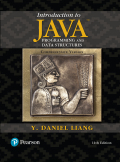
Concept explainers
a)
Pass-by-value:
A copy of the argument’s value which is passed into the parameter variable is referred as pass by value. In the pass by value, the called method creates new variables to store the value of the arguments passed to it. The changes made in the formal parameters do not reflect on the actual parameters.
Example:
changeVal(int num);
Here, “changeVal” is the method name and the “num” is the argument passed by value.
b)
Pass-by-value:
A copy of the argument’s value which is passed into the parameter variable is referred as pass by value. In the pass by value, the called method creates new variables to store the value of the arguments passed to it. The changes made in the formal parameters do not reflect on the actual parameters.
Example:
changeVal(int num);
Here, “changeVal” is the method name and the “num” is the argument passed by value.
c)
Pass-by-value:
A copy of the argument’s value which is passed into the parameter variable is referred as pass by value. In the pass by value, the called method creates new variables to store the value of the arguments passed to it. The changes made in the formal parameters do not reflect on the actual parameters.
Example:
changeVal(int num);
Here, “changeVal” is the method name and the “num” is the argument passed by value.
d)
Pass-by-value:
A copy of the argument’s value which is passed into the parameter variable is referred as pass by value. In the pass by value, the called method creates new variables to store the value of the arguments passed to it. The changes made in the formal parameters do not reflect on the actual parameters.
Example:
changeVal(int num);
Here, “changeVal” is the method name and the “num” is the argument passed by value.
Want to see the full answer?
Check out a sample textbook solution
Chapter 6 Solutions
Introduction to Java Programming and Data Structures Comprehensive Version (11th Edition)
- Describe three (3) Multiplexing techniques common for fiber optic linksarrow_forwardCould you help me to know features of the following concepts: - commercial CA - memory integrity - WMI filterarrow_forwardBriefly describe the issues involved in using ATM technology in Local Area Networksarrow_forward
- For this question you will perform two levels of quicksort on an array containing these numbers: 59 41 61 73 43 57 50 13 96 88 42 77 27 95 32 89 In the first blank, enter the array contents after the top level partition. In the second blank, enter the array contents after one more partition of the left-hand subarray resulting from the first partition. In the third blank, enter the array contents after one more partition of the right-hand subarray resulting from the first partition. Print the numbers with a single space between them. Use the algorithm we covered in class, in which the first element of the subarray is the partition value. Question 1 options: Blank # 1 Blank # 2 Blank # 3arrow_forward1. Transform the E-R diagram into a set of relations. Country_of Agent ID Agent H Holds Is_Reponsible_for Consignment Number $ Value May Contain Consignment Transports Container Destination Ф R Goes Off Container Number Size Vessel Voyage Registry Vessel ID Voyage_ID Tonnagearrow_forwardI want to solve 13.2 using matlab please helparrow_forward
- a) Show a possible trace of the OSPF algorithm for computing the routing table in Router 2 forthis network.b) Show the messages used by RIP to compute routing tables.arrow_forwardusing r language to answer question 4 Question 4: Obtain a 95% standard normal bootstrap confidence interval, a 95% basic bootstrap confidence interval, and a percentile confidence interval for the ρb12 in Question 3.arrow_forwardusing r language to answer question 4. Question 4: Obtain a 95% standard normal bootstrap confidence interval, a 95% basic bootstrap confidence interval, and a percentile confidence interval for the ρb12 in Question 3.arrow_forward
 C++ Programming: From Problem Analysis to Program...Computer ScienceISBN:9781337102087Author:D. S. MalikPublisher:Cengage Learning
C++ Programming: From Problem Analysis to Program...Computer ScienceISBN:9781337102087Author:D. S. MalikPublisher:Cengage Learning Microsoft Visual C#Computer ScienceISBN:9781337102100Author:Joyce, Farrell.Publisher:Cengage Learning,
Microsoft Visual C#Computer ScienceISBN:9781337102100Author:Joyce, Farrell.Publisher:Cengage Learning, C++ for Engineers and ScientistsComputer ScienceISBN:9781133187844Author:Bronson, Gary J.Publisher:Course Technology Ptr
C++ for Engineers and ScientistsComputer ScienceISBN:9781133187844Author:Bronson, Gary J.Publisher:Course Technology Ptr EBK JAVA PROGRAMMINGComputer ScienceISBN:9781337671385Author:FARRELLPublisher:CENGAGE LEARNING - CONSIGNMENT
EBK JAVA PROGRAMMINGComputer ScienceISBN:9781337671385Author:FARRELLPublisher:CENGAGE LEARNING - CONSIGNMENT



